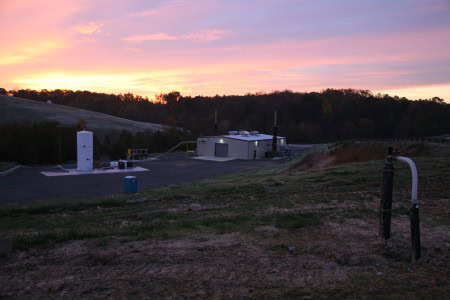EPA recognizes Randolph College among nation's leading green power users
LYNCHBURG, VA — The U.S. Environmental Protection Agency (EPA) has named Randolph College as one of the agency’s Green Power Partnership Top Partners. Randolph was included in the EPA’s recent Top Partner list for Long-Term Green Power Contracts for its commitment to purchase electricity from clean energy sources.

The Henrico County power plant operated by Ingenco, which burns waste landfill gas to generate electricity for Randolph College and other customers.
Earlier this year, Randolph signed a contract to purchase electricity from Collegiate Clean Energy, a subsidiary of Ingenco, a company that generates electricity by burning waste gas from landfills. Thanks to this 12-year agreement, Randolph College is using 5 million kilowatt-hours (kWh) of green power annually, which is enough green power to meet 77 percent of the organization’s electricity use. Randolph College has a 12-year contract to purchase a utility green power product from Ingenco. This demonstrates a proactive choice to switch away from traditional sources of electricity generation and support cleaner renewable energy alternatives.
The EPA invited Randolph to participate in the Green Power Partners program because of the agreement with Ingenco, said Ludovic Lemaitre, the Randolph College sustainability coordinator.
“This is a significant step for the College because it demonstrates that a small liberal arts college can purchase virtually all of its electricity from clean, domestic, and renewable sources at the same cost, or a lower cost, than electricity produced from health- and environment-degrading sources,” Lemaitre said.
Using clean energy sources advances Randolph College’s own goals to improve environmental sustainability. The College was the first in Virginia to sign the American College & University Presidents’ Climate Commitment.
“A commitment to green power is a significant step towards greater environmental sustainability at Randolph College consistent with our Climate Action Plan,” said Karin Warren, the Herzog Family Chair of Environmental Studies and chair of the Sustainability Council at Randolph College. “We’ll be reducing our contribution to greenhouse gases in the atmosphere by moving away from coal-fired electricity.”
Green power is electricity that is generated from environmentally preferable renewable resources, such as wind, solar, geothermal, biogas, eligible biomass, and low-impact hydro. Using green power helps accelerate the development of new renewable energy capacity nationwide and helps reduce greenhouse gas emissions from the power sector.
According to the U.S. EPA, Randolph College’s green power use of 5 million kWh is equivalent to avoiding the carbon dioxide (CO2) emissions of more than 700 passenger vehicles per year, or the CO2 emissions from the electricity use of nearly 500 average American homes annually.
About Randolph College
Located in Lynchburg, Virginia, Randolph College is a nationally recognized, private, liberal arts and sciences institution known for its excellent academic program, nationally ranked professors, rich traditions, and close, diverse community. Randolph features an innovative learning community where a classic liberal arts education intersects with practical preparation for a rapidly-changing world. Founded in 1891 as Randolph-Macon Woman’s College, Randolph offers academic and co-curricular programs designed to challenge students to develop their intellectual and creative talents and pursue educational opportunities in and out of the college community. The College’s motto, Vita abundantior, (“the life more abundant”) expresses its historical emphasis on the importance of a quality liberal arts education to a rich, full life. To learn more see www.randolphcollege.edu.
About EPA’s Green Power Partnership
The Green Power Partnership is a voluntary program that encourages organizations to use green power as a way to reduce the environmental impacts associated with electricity use. The Partnership currently has more than 1,300 Partner organizations voluntarily using billions of kilowatt-hours of green power annually. Partners include a wide variety of leading organizations such as Fortune 500® companies; small and medium sized businesses; local, state, and federal governments; and colleges and universities. For additional information, please visit http://www.epa.gov/greenpower.

